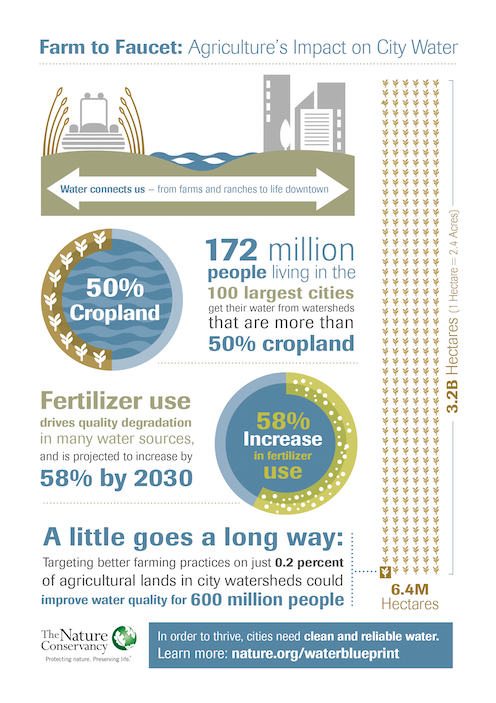Natural Solutions to the Global Water Challenge
Each year, cities around the world spend $90 billion to build infrastructure that’s used to deliver and treat water. To meet the needs of growing urban populations, some cities transport clean water thousands of kilometers to their residents, while other cities invest in more complex technology to treat local water resources. But nature has an important role to play in water delivery and treatment, one that has gone largely untapped.
The Nature Conservancy, in partnership with C40 Cities Climate Leadership Group and the International Water Association, has released a new report, Urban Water Blueprint: Mapping Conservation Solutions to the Global Water Challenge, which analyzes the state of water among more than 2,000 water sources and 530 cities worldwide. The report offers science-based recommendations for natural solutions that can be integrated alongside traditional infrastructure to improve water quality.
While the 100 largest cities in the world occupy less than 1 percent of our planet’s land area, their source watersheds—the rivers and land where cities get their water—cover more than 12 percent. That’s an area of land roughly the size of Russia—1.7 billion hectares——that collects, filters and transports water to nearly a billion people before it ever enters a pipe.
Although watersheds are vital to the urban water supply, they typically receive little investment. In reality, protecting water at its source can be cheaper and more efficient than treating it after it has already been polluted. The Urban Water Blueprint indicates for the first time that one in four cities could have a positive return on investment from investing in watershed conservation.
Investing in natural solutions such as forest protection, reforestation, stream bank restoration, improved agricultural practices and forest fire management can reduce sediment and nutrient pollutants that flow into drinking water sources. These solutions have the potential to improve water quality for more than 700 million people around the world.
The Urban Water Blueprint, for example, shows that applying natural solutions to working landscapes, such as farms and ranches, has the greatest potential to improve water quality in many large cities—which is increasingly important as cropland is projected to increase 10 percent globally by 2030. The report reveals that 600 million city dwellers would see a material improvement in the quality of their water sources if agricultural best management practices were targeted to some 6.4 million hectares, or just 0.2 percent of cropland area.
The Urban Water Blueprint and accompanying interactive website serve as a tool for decision makers in evaluating water quantity and quality risk across the world’s largest cities, the steps cities have taken to overcome water stress, and the cost-benefits of incorporating natural solutions. Since the benefits of natural solutions often extend beyond municipal boundaries, the report outlines unique financing mechanisms that cities, water utilities and partners can use to share the cost of implementing these solutions in shared watersheds.
Cities that embrace both natural and traditional engineered infrastructure solutions will not only meet future water demand; they will reshape our planet’s landscape for the better.
Visit nature.org/waterblueprint to explore for yourself.


